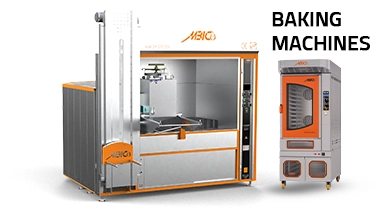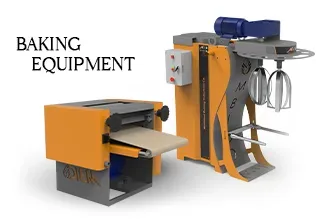Recipe
Unveiling Aish Merahrah: The Ancient Egyptian Sourdough Flatbread with a Modern Twist
I’ll never forget the first time I tasted Aish Merahrah. It was in a bustling market in Cairo, a simple flatbread, yet it held a depth of flavor I hadn’t encountered before – earthy, slightly bitter, with an incredible tang. It wasn’t just bread; it was a story, a history baked into every bite. My initial attempts to replicate it in my own kitchen were… humbling, to say the least.
Many passionate home bakers, and even seasoned professionals, understand this challenge: how do you capture the essence of a traditional bread, especially one with unique ingredients like fenugreek, and the complexities of a sourdough culture? It’s a delicate balance of science, art, and intuition. This quest for authentic flavor, combined with the desire for consistent quality and scale, is precisely where innovators in bakery technology step in. As a leading manufacturer of high-quality bakery equipment, MBICO understands that empowering bakers to achieve professional results requires not just passion, but also precision engineering and reliable machinery. We’re dedicated to bridging the gap between ancient traditions and modern efficiency.
By the end of this article, you will have a deep understanding of Aish Merahrah’s unique characteristics, from its distinctive corn and fenugreek profile to the nuances of its sourdough fermentation, and learn the exact techniques to apply this knowledge in your own kitchen to create truly exceptional loaves.
The Heart of Egypt: Understanding Aish Merahrah
Aish Merahrah, often simply called ‘Merahrah,’ is more than just a staple in Egyptian households; it’s a testament to ancient baking wisdom. This sourdough flatbread, deeply rooted in the country’s culinary heritage, sets itself apart through its core ingredients and a fermentation process that sings of tradition.
A Legacy of Flavor: Corn and Fenugreek
The distinctive character of Aish Merahrah begins with its unique grain combination: corn and fenugreek. Unlike the common wheat-based breads we often encounter, the corn flour in Merahrah contributes a tender crumb and a subtle sweetness that balances the robust flavors. From a food science perspective, corn flour’s lower protein content means less gluten development, which can lead to a softer, more crumbly texture, characteristic of this flatbread. This is where a master baker learns to adjust hydration and fermentation to achieve the desired chew.
But it’s the fenugreek – often ground into a fine powder – that truly defines Aish Merahrah. Its aromatic, slightly bitter, and subtly sweet notes are unmistakable. I remember my first bite, a symphony of flavors that danced between earthy and almost maple-like. Fenugreek doesn’t just add flavor; its mucilaginous properties can also influence the dough’s hydration and texture, requiring a keen understanding of dough rheology. Based on principles outlined in texts like ‘Modernist Bread,’ understanding the interaction of such unique ingredients is crucial for mastering traditional recipes.
The Magic of Sourdough: Fermentation in Aish Merahrah
As a sourdough flatbread, Aish Merahrah harnesses the power of natural fermentation. This isn’t merely about leavening; it’s about flavor development, nutrient availability, and shelf life. The wild yeasts and lactic acid bacteria (LAB) in the sourdough starter work in synergy, converting complex carbohydrates into simpler sugars and organic acids. These acids—lactic, acetic, and propionic—are the architects of the bread’s characteristic tang and complex aroma. In my years of running a professional bakery, I’ve found that managing the ambient temperature and hydration during bulk fermentation is paramount for drawing out these nuanced flavors in sourdoughs like Aish Merahrah. A slower, cooler ferment will often yield a more pronounced sourness, while a warmer proof accelerates activity, producing a milder flavor profile.
Crafting Aish Merahrah: From Mill to Masterpiece
Bringing Aish Merahrah to life in your kitchen requires attention to detail at every stage, from selecting your ingredients to the final bake. This journey is where the craft of baking truly shines.
Sourcing and Milling: The Foundation of Flavor
The quality of your corn flour and fenugreek can make or break your Aish Merahrah. Opt for stone-ground corn flour if possible, as it often retains more of the germ and bran, contributing to a richer flavor and nutritional profile. For fenugreek, freshly ground seeds are always superior to pre-ground, which can lose potency quickly. For larger scale operations, procuring high-quality ingredients efficiently is key, a challenge that a specialized manufacturer like MBICO helps address through robust machinery designed for consistent production.
The Sourdough Starter: Lifeblood of Your Loaf
Your sourdough starter, or ‘mother,’ is the heart of your Aish Merahrah. A vibrant, active starter will ensure proper leavening and optimal flavor development. Maintaining a consistent feeding schedule and understanding how different flour ratios impact its activity are essential. For Aish Merahrah, a relatively stiff starter (lower hydration) might be preferred by some for greater control over dough consistency, while others might opt for a more liquid one to introduce additional moisture. Experimentation here is highly encouraged.
Mixing, Fermentation, and Shaping: A Baker’s Dance
The mixing process for Aish Merahrah is less about developing strong gluten (due to the corn flour) and more about achieving an even distribution of ingredients. Gentle mixing, followed by a period of autolyse, can help the corn flour fully hydrate. The bulk fermentation, often spanning several hours, is where the magic happens. Monitoring the dough’s rise and feeling its readiness – the ‘jiggle test’ – becomes second nature with practice. Once fermented, the dough is typically divided and shaped into relatively thin, round flatbreads. Tools designed for precision, such as industrial mixers and dough dividers, can streamline this process for both artisanal bakeries and larger production facilities.
The Heat of the Moment: Baking Aish Merahrah to Perfection
The final stage of baking Aish Merahrah is where all your hard work comes to fruition, demanding precise temperature control and an understanding of how heat transforms your dough.
The Ideal Bake: Temperature and Time
Like many flatbreads, Aish Merahrah thrives in a hot environment. High temperatures, typically between 450-500°F (230-260°C), are crucial for achieving that characteristic puff and slight crispness on the exterior while maintaining a soft, pliable interior. This intense heat promotes rapid oven spring and triggers the Maillard reaction, developing those beautiful golden-brown hues and complex savory flavors on the crust. A robust bakery oven capable of maintaining consistent high temperatures is indispensable for achieving these results, whether in a home kitchen or a professional setting.
Troubleshooting Common Aish Merahrah Challenges
- Too dense? This often indicates an inactive starter, insufficient fermentation, or too low a baking temperature. Ensure your starter is robust and your bulk ferment shows clear signs of activity.
- Lack of fenugreek flavor? Check the freshness of your fenugreek powder. It can lose its potency quickly.
- Too dry or brittle? Adjust your dough’s hydration. Corn flour can absorb liquid differently, so a slightly higher hydration might be necessary.
Remember, baking is an iterative process. Even the most versatile pizza and food ovens that excel at high-temperature baking require a baker’s keen eye and adjustments for perfect results across different recipes. Each bake is an opportunity to learn and refine your technique.
Aish Merahrah is a truly remarkable bread, a culinary bridge between ancient Egyptian tradition and the intricate science of sourdough baking. By understanding the unique interplay of corn flour, aromatic fenugreek, and the dynamic world of fermentation, you can unlock its rich, distinctive flavors. It’s a journey that demands patience, observation, and a willingness to embrace the nuanced magic of traditional bread-making.
This weekend, I encourage you to embark on your own Aish Merahrah adventure. Try experimenting with your starter’s hydration by just 1-2%, or vary your bulk fermentation time slightly to observe the subtle differences in texture and flavor. Trust your instincts, feel the dough, and savor the profound satisfaction of baking a piece of history. Happy baking!







Explore MBICO's categories
Bakery equipment
13 Products
bulk and semi-bulk bread baking ovens
3 Products
Bulk Breads Baking equipment
14 Products
Confectionery equipment
7 Products
Mini ovens
3 Products
Pizza and food ovens
4 Products
Baking equipment
25 Products
Bakery oven
5 Products
Tafton baking ovens
3 Products
Barbari baking ovens
4 Products
Sangak bakery ovens
3 Products
Lavash baking ovens
3 Products
Pastry and confectionery ovens
3 Products
Baking ovens
10 Products
Mobile baking machines
4 Products
Explore MBICO's products
Steam Generator
Mobile Bakery Container
Conveyor Pizza Oven
Dough Bowl
Bakery cooling rack
Portable Rotary Semi – Automatic Oven for Baking Traditional Breads
Verticsl Dough Bowl Lift
Rimok Bakery